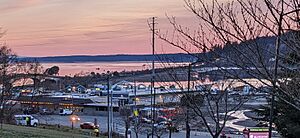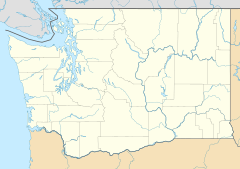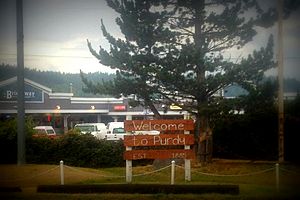Purdy, Washington facts for kids
Quick facts for kids
Purdy
|
|
|---|---|

The town of Purdy with the Purdy Bridge and Purdy Sandspit visible in the background
|
|
| Country | United States |
| State | Washington |
| County | Pierce |
| Unincorporated community | Purdy |
| Area | |
| • Total | 2.34 sq mi (6.1 km2) |
| • Land | 2.34 sq mi (6.1 km2) |
| Elevation | 30 ft (9 m) |
| Population
(2010)
|
|
| • Total | 1,544 |
| ZIP code |
98332
|
| Area code(s) | 253 |
| GNIS feature ID | 1512585 |
Purdy is a small town in Washington state. It is located north of Gig Harbor. Purdy sits where two main roads, State Route 16 and State Route 302, meet. It is found on the northern edge of Pierce County.
Purdy is right by the water, on the edges of Burley Lagoon and Henderson Bay. These waters are part of Puget Sound. A narrow strip of land called a sandspit and the Purdy Bridge separate the lagoon and the bay.
A women's prison, the Washington Corrections Center for Women, is nearby. It is often called "Purdy," even though its official address is in Gig Harbor. In 2010, about 1,544 people lived in Purdy.
Contents
The Story of Purdy: A Look Back
Before settlers from Europe arrived, Native American tribes lived in the Purdy area. They used to fish and dig for clams in Henderson Bay.
How Purdy Got Its Name
In 1884, a man named Isaac Hawk sold 19 acres of land. A logger and Civil War veteran named Horace Knapp bought the land. He divided it into smaller pieces to create the town of Purdy.
The town was named after Joseph W. Purdy. He was a grocer from Tacoma, Washington. Joseph Purdy gave the materials to build the community's first schoolhouse. Horace Knapp donated the land for the school.
Early Settlers and Logging Life
On February 8, 1885, Horace Knapp married Josephine Fuller. They moved to the Purdy area. Josephine became the first white female settler in Purdy.
Horace Knapp owned a special logging camp that floated on Burley Lagoon. It had a kitchen and beds for the loggers.
The Purdy Mill and Its Success
In 1885, a lumber mill was built by James Ashton, Joseph Purdy, William Rowland, and a Mr. Sherman. It was located on a small inlet of Burley Lagoon.
In 1886, the Purdy mill got a big job. It had to provide huge pieces of wood for a wooden dry dock at Puget Sound Naval Shipyard in Bremerton. The mill was able to offer a lower price than others. This was because they used an extra saw to cut a special bevel (a sloped edge) on the wood. This made their work faster.
Purdy became known as a busy mill town. The mill's success brought new things to the area. These included a grocery store and a post office. The post office was on Knapp's floating camp from 1886 to 1895. Later, it moved to Springfield, which is now Wauna, Washington.
A long chute was built along what is now 144th Street. It was used to slide logs down the hill into the water. Around 1900, a man known as "the Frenchman" started canning native Olympia oysters. He gathered them from his land on the Purdy sandspit. He gathered so many that these native oysters almost disappeared. Today, Japanese oysters and clams are still grown on Purdy's sandbars and in Burley Lagoon.
Purdy's Schools Through Time
The first schoolhouse in Purdy was no longer used in the 1890s. In 1900, a second Purdy Schoolhouse was built to replace it. Horace Knapp also donated the land for this school. It was located on Sherman Avenue, which is now 68th Avenue.
Students used to switch between the Purdy Schoolhouse and the Wauna Schoolhouse every other semester. This helped keep both schools active. Today, Peninsula High School sits on the hill where one of the first schoolhouses was built. The second schoolhouse stood until 2015, when it was taken down to build a new home.
See also
 In Spanish: Purdy (Washington) para niños
In Spanish: Purdy (Washington) para niños



